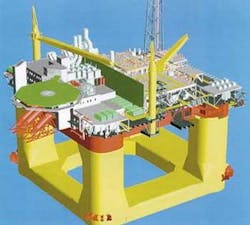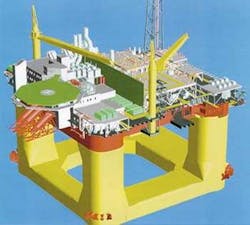Norway: Newly-merged Aker Kværner group clinches Kristin construction contract
Aker Maritime, now assimilated into Aker Kværner, has landed another notable floater assignment, the NKr 5 billion project management contract for Stat-oil's Kristin production platform. The semisubmersible unit is due to be delivered on May 25, 2005.
The company's responsibility covers engineering, procurement, construction, and hook-up. But its scope does not cover the whole platform. "Statoil did not feel comfortable about giving EPC responsibility for the whole platform," says Aker Maritime's project manager Jens Christian Halling. "It has taken out the fabrication of the hull, riser module, and flare tower, while the living quarters will be let as a separate EPC contract."
The platform will have a topsides weight of 17,500 tonnes and a hull of 13,000 tonnes. That makes it a little smaller than the Snorre B production platform which Aker Maritime and Kværner Oil & Gas jointly delivered to Norsk Hydro in May 2001. Halling was also project manager for the completion stage of that job.
The Kristin contract was awarded in January, two months before the Aker Kværner merger. In its bid Aker Maritime proposed performing engineering and procurement using its resources in Stavanger, but shortly after the award was made, and with the merger in mind, it announced that the engineering and procurement would instead be subcontracted to Kværner Oil & Gas. The activities will be performed from Kværner Oil & Gas' office at Høvik outside Oslo. The decision provides continuity with the earlier design work since the bid was based on the front-end engineering design prepared by Kværner and GVA Consultants.
The main contract partner is Aker Stord, which will build the process and utility modules, assemble the topsides and mate the deck and hull at its yard in western Norway. "One of the major reasons we were successful is that we could build the process and utilities at the same time at Stord. It's less costly to build at the same place, and requires less personnel for follow-up," says Halling. "Both will be built indoors over the dry dock." The process module has a weight of 6,500 tonnes and the utility module 5,450 tonnes. Stord's track record includes the EPC provision of Hydro's Njord platform, which like Snorre B was built to an Aker design.
The living quarters, a 1,220-tonne structure with 104 beds, was tendered in February and will be awarded in spring. Bids for the hull are due to be issued in April and those for the 4,050-tonne riser balcony in June. The 280-tonne flare tower will be tendered over summer.
Aker Kværner plans to bid for the riser balcony. The arrangement for risers includes a guide at pontoon level, which will provide additional support. This is different from the Snorre B platform, on which the risers are only supported at deck level. The riser guide will give a positive element to stability and riser protection, says Halling.
Other group companies have been subcontracted to contribute to the project. Aker Technology is providing engineering resources, and Aker Verdal Cold Bending will perform the cold bending of piping. Electrical, instrumentation, and telecommunications facilities will be engineered and installed by Aker Elektro. Aker Marine Contractors will be interested in bidding for platform tow-out and installation.
A key issue in the Kristin assignment will be the contractor's common system responsibility from the subsea wells through to export. Kristin is a high-pressure, high-temperature field. In fact, with a reservoir pressure of 900 bar and temperature of 170°C, it is the most HP/HT field yet to be developed in Norway. "Here there's quite a challenge," says Halling. "This will test the limits of the piping and valving equipment." With a production capacity of 18 MMcm/d of gas and 125,000 b/d of condensate, it will also handle large volumes of hydrocarbons.
Engineering and procurement work got under way early in the year, soon after contract award. Fabrication at Stord will not begin until January 2003. Topsides assembly starts in March 2004, and deck/hull mating is scheduled for August 2004. "We feel comfortable with the time available, we've got a fairly long period for executing the project," says Halling. Statoil is clearly keen to avoid the kind of problems encountered on previous projects when significant design changes had to be implemented after fabrication was well under way. For Kristin, detailed design will be well advanced before fabrication begins.
Commissioning is due to start 15 months before delivery, a fairly early stage. Statoil will take responsibility for this role, as is normal in Norway. On Snorre B, however, it was Aker Maritime that had responsibility for commissioning. This gave it the opportunity for seamless working, and made a major contribution to the success of the project, Halling notes. "We hope we'll be heavily involved in the Kristin commissioning," he says.
The project will be planned and performed in accordance with Aker Maritime's execution model. A lot of effort has gone into establishing the model, which details to a large extent what information is needed at what stage in the project. It is currently in use on two other Aker Stord contracts, BP's Valhall water injection platform and Hydro's Grane drilling module, where it is making valuable contributions to improved productivity.
The model is intended to enable close quality assurance to be maintained at all stages of the project. Required quality levels are defined at the engineering and procurement stage, and checklists are drawn up for each deliverable at each stage.
There is also a strong focus on system completion and follow-up. For example, instead of piping and structural activities proceeding separately, the project engineers have responsibility from day one of maintaining an overview of the progress of all activities. This is particularly important in the case of multidisciplinary tasks. "This approach should make the total project execution, including commissioning, more efficient," says Halling. "Our focus is firmly fixed on the end-product."
The completed platform is due to leave Stord in March 2005, two months before handover. Production operations will begin in the following July, allowing a run-in period of three months before gas exports start in October 2005.

